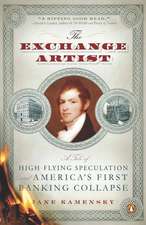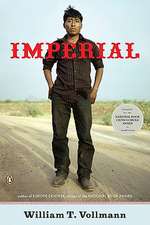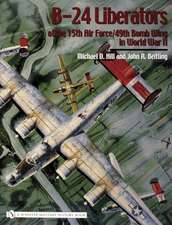The Free and the Unfree: A Progressive History of the United States
Autor Peter N. Carroll, David W. Nobleen Limba Engleză Paperback – 31 iul 2001
The founding Fathers based the American system on principles of equality and freedom, but often people who made America their home faced inequality, injustice, and legal discrimination. The Free and the Unfree documents what happened when Native Americans, African Americans, immigrants, religious minorities, and women tested America's humanitarian and democratic principles. It surveys the social, cultural, political, and economic developments that broadened America's definition of freedom-from the earliest contacts with Native Americans and the Revolutionary War through the Civil Rights movement and the sexual revolution. The Free and the Unfree presents a concise, thorough, and up-to-date examination of the spirit and limits of freedom, providing readers with a little-known perspective on American history.
Preț: 194.84 lei
Nou
Puncte Express: 292
Preț estimativ în valută:
37.29€ • 38.60$ • 31.52£
37.29€ • 38.60$ • 31.52£
Carte disponibilă
Livrare economică 13-27 februarie
Preluare comenzi: 021 569.72.76
Specificații
ISBN-13: 9780141001586
ISBN-10: 0141001585
Pagini: 503
Dimensiuni: 129 x 199 x 24 mm
Greutate: 0.35 kg
Ediția:Revizuită
Editura: Penguin Books
ISBN-10: 0141001585
Pagini: 503
Dimensiuni: 129 x 199 x 24 mm
Greutate: 0.35 kg
Ediția:Revizuită
Editura: Penguin Books
Cuprins
Acknowledgments
Preface to the Second Edition
Preface to the First Edition
Part One: American Societies: From Settlement to Nation
Chapter 1: Native Americans Meet Native Europeans
Native American Cultures and their lands. The first contact: Columbus and European exploration. The European background: Protestant Reformation, political nationalism, economic change, Renaissance curiosity. Race for empire: early exploration, conquest, and colonization.
Chapter 2: The Transplantation.
The instruments of European expansion. Tudor England on the eve of colonization. Anglican and Puritan conflict. Jamestown: first permanent English settlement. Puritans in New England. Proprietary colonies. Organizing space and time. The colonial family. Colonial religion: the Great Awakening and religious toleration.
Chapter 3: Colonial Economy and Social Structure
New England commerce and southern tobacco economy. Commerce and conflict in the Middle Atlantic colonies. Mercantilism and the Navigation Acts. Westward expansion vs. Native American interests. Slavery and black society. The provincial elite. Social mobility and social stratification on the eve of revolution.
Chapter 4: Politics and the American Revolution
Political values and the emergence of modern politics. Colonial political structure. The imperial wars and the Treaty of Paris. England's great war for empire and colonial protest against taxation and other Intolerable Acts. The War for Independence: origins, military engagements, peace settlement. Establishing state governments. The Articles of Confederation: the first national government and the call for reform.
Chapter 5: The Constitution and American Identity
Cultural nationalism after 1776. Constitution making: the Philadelphia convention, Federalists vs. Antifederalists, ratification, and political consensus. The emergence of national identity. Thomas Jefferson's legacy to America.
Part Two: National Expansion: From Constitution to Civil War
Chapter 6: Social Patterns North and South
Marriage and the family. Morality and religion. The organization of time in American life: the clock industry. Growth of factories, transportation, and industrial markets. Population growth and European immigration. Industrial values and the urban working class. Social structure in northern industrial society. Southern slavery and black culture: plantation economy and King Cotton, black challenges to slavery. Attitudes toward women and children. Women's rights and Seneca Falls.
Chapter 7: The Organization of Space
Western expansion and Manifest Destiny. Geographical exclusion: wars with Native Americans and removal to reservations. Texas and the Mexican War. The colonization movement vs. abolitionism. Persecution of Mormons. Urban planning and the growth of cities: grid plans. Anti-Catholicism: nativism and the Know-Nothing party. Consequences of racial separation: urban violence. Nineteenth-century reforms: prisons, asylums, and the environment.
Chapter 8: Politics and Power
Founding the Republic: the paradox of political parties and local politics. Alexander Hamilton's financial program and the beginnings of national political parties: Republicans vs. Federalists. Foreign-policy formulations under Washington, Jefferson, and Madison. War of 1812. Era of Good Feelings: nationalism vs. sectionalism, the Missouri Compromise, and political reform. Andrew Jackson, president of the people: Democrats vs. Whigs, the Bank War, nullification controversy, and the Tariff of Abominations. Presidential election, 1856: Dred Scott Decision, Lincoln in office, sectional crisis, secession and the coming of civil war.
Chapter 9: The Civil War and American Identity
The war and its aftermath: strategies, battles, death immersion, Emancipation Proclamation. The weakness of the Confederacy and the triumph of the nationalist attitude. The Lincoln Presidency and republican destiny: biracial society, Native Americans, social values, and family relations. Lincoln, symbol of unity and death.
Part Three: An International Frontier Opens as the Western Frontier Closes
Chapter 10: The Collapse of Nineteenth-Century Culture
Debacle in the West for Native Americans: reservations and the Dawes Act, disaster at Wounded Knee. Spiritual crisis and other threats to white Protestant values and religious manifest destiny: divorce, fear of sex and death, changing role of women. Social activism: The Purity Crusade. The Teddy Roosevelt ideal. Socializing adolescents and dependent children for class roles. Blacks: citizens only in the eyes of the law.
Chapter 11: The New Industrial Economy
Railroads transform regional trade to a national economy. The modern corporation. Growth of organized labor. Expansion and mechanization of agriculture. Growth of the metropolis and the urban labor force. The black ghetto: treadmill of poverty and underemployment.
Chapter 12: Politics in the Late Nineteenth Century
Reconstruction. Democratic party and the "new South." New industrial elite and the politics of corruption. Populism: the People's party allies with Democrats. Harnessing racial resentment against blacks: disenfranchisement, legalized segregation, and the Ku Klux Klan. Women in politics and women's suffrage. Regulation of power in Washington.
Chapter 13: The End of Isolation, 1898-1920
President Theodore Roosevelt's two terms. President Woodrow Wilson: the man in office. Exploiting foreign markets. America's Open Door Policy. War in Europe, 1914, and American neutrality. The United States enters World War I.
Part Four: The Closing of Frontiers at Home and Abroad, 1920-86
Chapter 14: Prosperity and Depression, 1920-40
Postwar disillusionment: failure of the Purity Crusade, the jazz era, and the "lost generation." Explosion of black culture and black pride. Postwar corporate boom. Herbert Hoover: at the helm of a consumer economy. Stockmarket disaster: facing the depression. Roosevelt's emergency measures.
Chapter 15: War, Economic Prosperity, and Consensus, 1936-60
Re-election of FDR. Japan and Germany threaten American neutrality. War is declared. War economy means economic prosperity. FDR on social issues. Truman completes FDR's fourth term. Cold war with the Soviet Union: Marshall Plan and NATO. The collapse of Nationalist China. Korean conflict. Eisenhower, the Red scare, and the arms race. The end of American innocence.
Chapter 16: New Visions, New Ethics, 1950-70
Voices of the beatnik poets. Ecology: a "counterculture" science. Children in the counterculture. Changing sex and social roles: women's liberation. Lifting taboos on aging and death. TV: mirror of modern times.
Chapter 17: Patterns of Economic Change, 1960-76
The Kennedy-Rostow economy. Economic change and the black community. The growth of space technology. Lyndon Johnson's War on Poverty. International corporate growth. Inflation and recession. Nixon faces the economic crunch. Oil crisis. Curbing environmental exploitation. Limits to growth.
Chapter 18: American Foreign Policy and Domestic Politics, 1960-76.
John F. Kennedy and Cuba. Escalating involvement in Vietnam. Johnson's Vietnam war. Civil-rights activism and change. Native Americans and "Red Power." Political women. Nixon reunites Republican party, 1968. Abuses of the Presidency: Watergate.
Chapter 19: Politics and Society, 1976-86
Gerald Ford and the legacy of Watergate. The rise and fall of Jimmy Carter. Resurgence on the right. Reaganomics and the economic crisis. Iran-Contragate. Social Issues: the family, the elderly, and the poor.
Epilogue
Selected References
Index
Preface to the Second Edition
Preface to the First Edition
Part One: American Societies: From Settlement to Nation
Chapter 1: Native Americans Meet Native Europeans
Native American Cultures and their lands. The first contact: Columbus and European exploration. The European background: Protestant Reformation, political nationalism, economic change, Renaissance curiosity. Race for empire: early exploration, conquest, and colonization.
Chapter 2: The Transplantation.
The instruments of European expansion. Tudor England on the eve of colonization. Anglican and Puritan conflict. Jamestown: first permanent English settlement. Puritans in New England. Proprietary colonies. Organizing space and time. The colonial family. Colonial religion: the Great Awakening and religious toleration.
Chapter 3: Colonial Economy and Social Structure
New England commerce and southern tobacco economy. Commerce and conflict in the Middle Atlantic colonies. Mercantilism and the Navigation Acts. Westward expansion vs. Native American interests. Slavery and black society. The provincial elite. Social mobility and social stratification on the eve of revolution.
Chapter 4: Politics and the American Revolution
Political values and the emergence of modern politics. Colonial political structure. The imperial wars and the Treaty of Paris. England's great war for empire and colonial protest against taxation and other Intolerable Acts. The War for Independence: origins, military engagements, peace settlement. Establishing state governments. The Articles of Confederation: the first national government and the call for reform.
Chapter 5: The Constitution and American Identity
Cultural nationalism after 1776. Constitution making: the Philadelphia convention, Federalists vs. Antifederalists, ratification, and political consensus. The emergence of national identity. Thomas Jefferson's legacy to America.
Part Two: National Expansion: From Constitution to Civil War
Chapter 6: Social Patterns North and South
Marriage and the family. Morality and religion. The organization of time in American life: the clock industry. Growth of factories, transportation, and industrial markets. Population growth and European immigration. Industrial values and the urban working class. Social structure in northern industrial society. Southern slavery and black culture: plantation economy and King Cotton, black challenges to slavery. Attitudes toward women and children. Women's rights and Seneca Falls.
Chapter 7: The Organization of Space
Western expansion and Manifest Destiny. Geographical exclusion: wars with Native Americans and removal to reservations. Texas and the Mexican War. The colonization movement vs. abolitionism. Persecution of Mormons. Urban planning and the growth of cities: grid plans. Anti-Catholicism: nativism and the Know-Nothing party. Consequences of racial separation: urban violence. Nineteenth-century reforms: prisons, asylums, and the environment.
Chapter 8: Politics and Power
Founding the Republic: the paradox of political parties and local politics. Alexander Hamilton's financial program and the beginnings of national political parties: Republicans vs. Federalists. Foreign-policy formulations under Washington, Jefferson, and Madison. War of 1812. Era of Good Feelings: nationalism vs. sectionalism, the Missouri Compromise, and political reform. Andrew Jackson, president of the people: Democrats vs. Whigs, the Bank War, nullification controversy, and the Tariff of Abominations. Presidential election, 1856: Dred Scott Decision, Lincoln in office, sectional crisis, secession and the coming of civil war.
Chapter 9: The Civil War and American Identity
The war and its aftermath: strategies, battles, death immersion, Emancipation Proclamation. The weakness of the Confederacy and the triumph of the nationalist attitude. The Lincoln Presidency and republican destiny: biracial society, Native Americans, social values, and family relations. Lincoln, symbol of unity and death.
Part Three: An International Frontier Opens as the Western Frontier Closes
Chapter 10: The Collapse of Nineteenth-Century Culture
Debacle in the West for Native Americans: reservations and the Dawes Act, disaster at Wounded Knee. Spiritual crisis and other threats to white Protestant values and religious manifest destiny: divorce, fear of sex and death, changing role of women. Social activism: The Purity Crusade. The Teddy Roosevelt ideal. Socializing adolescents and dependent children for class roles. Blacks: citizens only in the eyes of the law.
Chapter 11: The New Industrial Economy
Railroads transform regional trade to a national economy. The modern corporation. Growth of organized labor. Expansion and mechanization of agriculture. Growth of the metropolis and the urban labor force. The black ghetto: treadmill of poverty and underemployment.
Chapter 12: Politics in the Late Nineteenth Century
Reconstruction. Democratic party and the "new South." New industrial elite and the politics of corruption. Populism: the People's party allies with Democrats. Harnessing racial resentment against blacks: disenfranchisement, legalized segregation, and the Ku Klux Klan. Women in politics and women's suffrage. Regulation of power in Washington.
Chapter 13: The End of Isolation, 1898-1920
President Theodore Roosevelt's two terms. President Woodrow Wilson: the man in office. Exploiting foreign markets. America's Open Door Policy. War in Europe, 1914, and American neutrality. The United States enters World War I.
Part Four: The Closing of Frontiers at Home and Abroad, 1920-86
Chapter 14: Prosperity and Depression, 1920-40
Postwar disillusionment: failure of the Purity Crusade, the jazz era, and the "lost generation." Explosion of black culture and black pride. Postwar corporate boom. Herbert Hoover: at the helm of a consumer economy. Stockmarket disaster: facing the depression. Roosevelt's emergency measures.
Chapter 15: War, Economic Prosperity, and Consensus, 1936-60
Re-election of FDR. Japan and Germany threaten American neutrality. War is declared. War economy means economic prosperity. FDR on social issues. Truman completes FDR's fourth term. Cold war with the Soviet Union: Marshall Plan and NATO. The collapse of Nationalist China. Korean conflict. Eisenhower, the Red scare, and the arms race. The end of American innocence.
Chapter 16: New Visions, New Ethics, 1950-70
Voices of the beatnik poets. Ecology: a "counterculture" science. Children in the counterculture. Changing sex and social roles: women's liberation. Lifting taboos on aging and death. TV: mirror of modern times.
Chapter 17: Patterns of Economic Change, 1960-76
The Kennedy-Rostow economy. Economic change and the black community. The growth of space technology. Lyndon Johnson's War on Poverty. International corporate growth. Inflation and recession. Nixon faces the economic crunch. Oil crisis. Curbing environmental exploitation. Limits to growth.
Chapter 18: American Foreign Policy and Domestic Politics, 1960-76.
John F. Kennedy and Cuba. Escalating involvement in Vietnam. Johnson's Vietnam war. Civil-rights activism and change. Native Americans and "Red Power." Political women. Nixon reunites Republican party, 1968. Abuses of the Presidency: Watergate.
Chapter 19: Politics and Society, 1976-86
Gerald Ford and the legacy of Watergate. The rise and fall of Jimmy Carter. Resurgence on the right. Reaganomics and the economic crisis. Iran-Contragate. Social Issues: the family, the elderly, and the poor.
Epilogue
Selected References
Index
Recenzii
In search of a book that captures the essence of American history? One that will appeal to undergraduates exhausted by dry-as-dust texts? One that will inform foreigners seeking a good introduction to this country's history? One that the intelligent lay person will enjoy? This is the book. I have used it in American survey courses and students have responded warmly. I have recommended it to foreign students and they have benefited. And I have recommended it to general readers without disappointing a one. There is good reason that The Free and the Unfree appears in its third edition.
---Michael Batinski,
Southern Illinois University
---Michael Batinski,
Southern Illinois University
Notă biografică
Peter N. Carroll has taught at the University of Minnesota, San Francisco State University, and Stanford University. He lives in Belmont, California.
David W. Noble is professor of history and American studies at the University of Minnesota. He lives in St. Paul, MN.
David W. Noble is professor of history and American studies at the University of Minnesota. He lives in St. Paul, MN.
Descriere
"The Free and the Unfree" surveys the social, cultural, political, and economic developments that broadened America's definition of freedom. A concise, thorough, and up-to-date examination of the spirit and limits of freedom.












